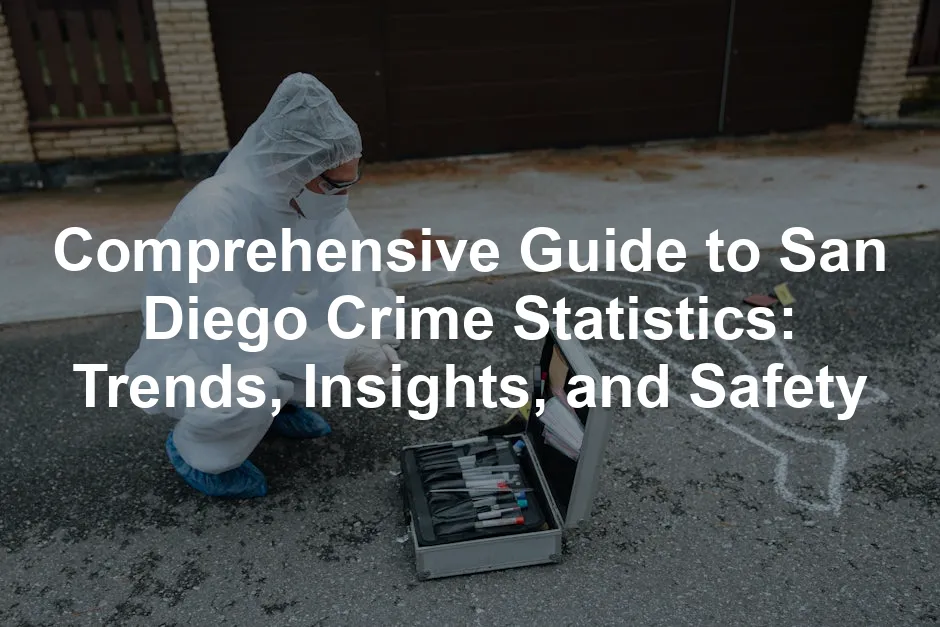Introduction
San Diego, with its stunning beaches and vibrant culture, is often seen as a paradise. But behind the sun-soaked facade lies an important topic: crime statistics. Understanding these numbers is crucial for residents, policymakers, and visitors alike. It helps everyone gauge the safety of neighborhoods, informs public policy, and shapes perceptions about this beautiful city.
Crime statistics are more than just numbers. They tell stories of communities and their challenges. For residents, knowing the crime landscape can guide choices about where to live or visit. For policymakers, these statistics are vital in allocating resources to combat crime effectively. And for potential visitors, awareness of crime rates can enhance safety during their stay.
The data we refer to comes from multiple reliable sources, including the San Diego Police Department and the FBI. These resources provide valuable insights into crime trends, allowing us to better understand the dynamics of safety in San Diego. Crime statistics not only reflect the current state of affairs but also shape public perception and influence policy decisions.
This article aims to provide a comprehensive analysis of crime statistics in San Diego. We’ll explore trends over time, compare crime rates across different neighborhoods, and discuss the broader impacts on community safety. Whether you’re a long-time resident or a newcomer, this guide will equip you with the information you need to navigate the streets of San Diego confidently.

Understanding San Diego Crime Statistics
What Are Crime Statistics?
Crime statistics are numerical representations of reported criminal activity within a specific area over a set period. They provide essential insights into the frequency and types of crimes occurring in a city. These statistics are collected through various means, primarily through reports filed by local law enforcement agencies.
The two main categories of crime are violent crimes and property crimes. Violent crimes include offenses like murder, rape, robbery, and aggravated assault. These crimes directly harm individuals and are often the most alarming to communities. On the other hand, property crimes encompass offenses such as burglary, theft, and motor vehicle theft. While they may not endanger lives, they can significantly affect the sense of safety and well-being in a neighborhood.

If you’re interested in understanding crime from a literary perspective, consider checking out Crime and Punishment by Fyodor Dostoevsky. It offers a deep dive into the psychology of crime and moral dilemmas that can resonate with our current societal issues.
Data Sources for San Diego Crime Statistics
When it comes to understanding crime in San Diego, various data sources play a significant role. The San Diego Police Department (SDPD) is a primary source, providing annual crime reports and real-time crime mapping. Their annual reports are submitted to the FBI as part of the Uniform Crime Reporting Program, ensuring a standardized approach to data collection.
State and federal agencies, including the California Department of Justice and the FBI, also contribute valuable data. They compile crime statistics from numerous law enforcement agencies, allowing for broader comparisons across cities and states.
Community resources, like neighborhood crime summary dashboards, offer residents near real-time access to crime data. These tools empower communities to stay informed and engaged, helping them understand local crime trends and take proactive measures to enhance their safety.
By leveraging these diverse data sources, San Diego can create a clearer picture of its crime landscape, allowing for informed decisions and enhanced community safety initiatives. Understanding where and why crimes occur is vital for developing effective strategies to reduce crime and improve the quality of life for all residents.

Current Crime Trends in San Diego
Overview of Recent Crime Data
San Diego has experienced various crime trends over the past few years. The latest reports reveal some intriguing insights into the city’s safety landscape. In 2023, the overall crime rate in San Diego was 18.97 per 1,000 residents, slightly below the national average. However, it’s crucial to note that the city’s crime rates are higher than 68% of other California cities.
The total number of crimes reported in San Diego reached 32,229, which includes 6,034 violent crimes and 26,195 property crimes. To break it down further, the city recorded 53 homicides, 425 rapes, 1,297 robberies, and 4,259 assaults. Property crimes included 3,406 burglaries, 15,894 thefts, and an alarming 6,895 vehicle thefts—one of the highest rates in the nation.
When comparing these statistics to previous years, a notable trend emerges. In the past two years, crime rates have fluctuated, with an overall decrease of about 2.7% from 2022 to 2023. This decline signifies that San Diego is making strides toward safety despite facing challenges.

Violent Crime Trends
Let’s dive into the types of violent crimes reported in San Diego. The four primary categories include murder, assault, robbery, and rape. The violent crime rate in San Diego stands at 4.37 per 1,000 residents, which is slightly above the national average of 4.00. While the murder rate has decreased by 16%, the robbery rate remains a point of concern, reflecting a 5.7% increase over the previous year.
In comparison to the state and national averages, San Diego’s violent crime statistics present a mixed bag. While the city has lower homicide rates than many major cities, aggravated assaults have seen an uptick. In 2023, police reported 4,490 aggravated assaults, marking a 5.6% increase from the prior year.

Property Crime Trends
Now, let’s shift gears to property crime. This encompasses various categories such as burglary, larceny, and vehicle theft. In San Diego, the property crime rate is 18.97 per 1,000 residents, which is lower than California’s average of 23.43. However, this still poses risks for residents.
Among property crimes, thefts account for the largest share, with 15,894 incidents reported. Burglary rates, on the other hand, have shown a positive trend with a 16% decrease from the previous year. Despite this, vehicle theft remains a persistent issue, with a staggering 6,895 reported cases, making San Diego one of the cities with the highest vehicle theft rates nationally.
To protect your vehicle, consider investing in a Security Camera System Wireless. This tech-savvy solution not only helps deter thieves but also provides peace of mind when you park your car.

Specific Crime Trends
Focusing on specific crime trends, let’s analyze homicide rates. In 2023, the city recorded 45 homicides, a decline from 52 in the previous year. Factors such as gang-related violence and domestic disputes continue to influence these numbers. Notably, six of these cases were linked to gang activity, indicating ongoing challenges for law enforcement.
Gang activity remains a significant concern for San Diego. The city has approximately 4,100 gang members across 91 gangs. This demographic often influences local crime rates, leading to increased violence in certain neighborhoods. Law enforcement agencies are actively combating gang-related issues through various initiatives, including targeted operations.
If safety is a concern for you, consider carrying a Personal Safety Alarm Keychain. This little gadget can be a lifesaver, alerting others in case of an emergency and giving you a sense of security while out and about.
In conclusion, while San Diego has seen decreases in overall crime rates, it still faces challenges, particularly in violent crime and vehicle theft. Understanding these trends is crucial for residents, policymakers, and visitors alike, as they navigate the complexities of urban safety. The city’s commitment to addressing these issues through community engagement and law enforcement is essential for fostering a safer environment for everyone.

Neighborhood Crime Statistics
Crime by Neighborhood
San Diego’s neighborhoods present a mixed bag of crime statistics, reflecting the city’s diverse socioeconomic landscape. Certain areas, such as East Village and Horton Plaza, have garnered attention for their higher crime rates. Factors contributing to these elevated rates include population density, proximity to nightlife, and economic challenges. High foot traffic can lead to increased opportunities for crime, particularly theft and vandalism.
On the flip side, neighborhoods like Pacific Highlands Ranch and Carmel Country Highlands stand out as safer havens. These areas benefit from a robust community engagement, lower population density, and higher median incomes, which often correlate with reduced crime rates. Residents here typically enjoy a sense of security, thanks to proactive neighborhood watch programs and community policing initiatives.
Understanding these neighborhood dynamics helps residents make informed decisions about where to live or visit, guiding them toward safer areas and away from those with higher risks.

Community Impact
Crime rates significantly influence public perception and community morale in San Diego. When crime spikes in certain neighborhoods, residents often feel anxious, prompting a ripple effect of fear throughout the community. This apprehension can hinder social interactions and lead to decreased community engagement, as people may hesitate to venture out after dark or participate in local events.
However, various community programs are actively working to combat these issues. Initiatives like the San Diego Police Department’s community engagement strategy focus on building trust between law enforcement and residents. Programs such as neighborhood watch groups and community patrols empower locals to take an active role in crime prevention. Furthermore, educational campaigns emphasize the importance of reporting suspicious activities, thereby fostering a culture of vigilance and cooperation.
You can also take safety into your own hands with a Pepper Spray for Self Defense. It’s a smart choice for personal safety, giving you a non-lethal way to fend off potential threats.
Ultimately, the interplay between crime statistics and community initiatives plays a crucial role in shaping San Diego’s safety landscape. When residents and law enforcement collaborate, they can foster an environment where safety is prioritized, and community morale thrives.

Law Enforcement Initiatives
Strategies for Crime Reduction
The San Diego Police Department (SDPD) employs multiple strategies to enhance public safety and reduce crime. One standout tactic is proactive policing, which focuses on preventing crime before it occurs. This approach includes targeted patrols in high-risk areas, which aim to deter potential offenders and reassure residents. The department also utilizes data-driven strategies, analyzing crime trends to allocate resources effectively and respond to emerging threats.
Community collaboration is another cornerstone of SDPD’s crime reduction efforts. By engaging with residents and local organizations, the department builds trust and encourages the sharing of information. This collaboration often results in community-led initiatives that address specific concerns, such as drug-related activities or gang violence. The success of these partnerships has been evident, as crime rates in actively engaged neighborhoods have seen noticeable declines.
Furthermore, SDPD has transitioned to the National Incident-Based Reporting System (NIBRS), which provides a more detailed understanding of crime. This enhancement allows for better tracking of crime patterns and the effectiveness of various initiatives. As a result, the department can adapt its strategies, focusing on areas that require immediate attention while celebrating successes in others.
If you’re looking for a comprehensive guide on personal safety, consider the The Complete Guide to Personal Safety by John Smith. This book equips you with essential knowledge and strategies to keep yourself and your loved ones safe.
In summary, the SDPD’s proactive and community-focused strategies are vital in shaping a safer San Diego. By fostering partnerships and leveraging data, law enforcement can effectively address crime while promoting a culture of safety and collaboration in neighborhoods across the city.

Future Directions for Crime in San Diego
Anticipating Trends
Predictive analysis is the crystal ball of crime statistics. By examining current data, law enforcement can forecast future crime trends. This process relies heavily on the historical data obtained from the newly implemented National Incident-Based Reporting System (NIBRS). With its detailed reporting, NIBRS allows for a more nuanced understanding of crime patterns.
For example, recent analyses show that aggravated assaults have increased by 5.6% in San Diego. If this trend continues, there could be a potential rise in other related offenses. Recognizing these patterns early can lead to proactive measures, allowing law enforcement to allocate resources effectively.
Moreover, crime data suggests that gang-related incidents are a persistent issue. With roughly 4,100 gang members in the city, strategies targeting these groups must remain a priority. By focusing on gang activity, it’s possible to mitigate related crimes and improve overall community safety.
Policies must adapt to these insights. Recommendations include increasing funding for community policing programs and enhancing collaboration between agencies. Building partnerships with local organizations can also create initiatives that address underlying social issues contributing to crime.

Community Involvement
Community involvement is the backbone of effective crime prevention. When residents actively participate in reporting suspicious activities, they play a pivotal role in enhancing safety. Encouraging open lines of communication between law enforcement and communities can foster trust and cooperation.
Workshops and community forums can educate residents on the importance of reporting crime. By highlighting the impact of their actions, residents can feel empowered to engage in crime prevention. This grassroots approach can create a culture of vigilance, where everyone looks out for one another.
Safety education is another crucial element. Ongoing programs tailored for schools, businesses, and neighborhoods can equip individuals with the tools to protect themselves. Topics could include personal safety, neighborhood watch initiatives, and emergency preparedness.
Speaking of preparedness, consider having an Emergency Preparedness Kit handy. It’s a smart move to ensure you’re ready for any unforeseen circumstances that might come your way.
In conclusion, a multi-faceted approach is essential for addressing crime in San Diego. By utilizing predictive analysis and encouraging community involvement, the city can foster a safer environment. Empowering residents through education and engagement can create a proactive culture of safety, where everyone contributes to crime prevention.

Conclusion
Understanding crime statistics in San Diego is essential for all stakeholders, from residents to policymakers. The data reveals a city making strides towards safety, with an overall crime rate of 18.97 per 1,000 residents. Interestingly, this rate is slightly below the national average. It’s important to highlight that San Diego’s crime rates are lower than many other California cities, ranking higher than only 68% of them.
The reported total number of crimes in 2023 stood at 32,229, comprising 6,034 violent crimes and 26,195 property crimes. Notably, the number of homicides decreased by 16% compared to previous years, a promising trend for community safety. However, challenges persist, particularly with vehicle theft, which remains alarmingly high at 6,895 incidents.
Property crime trends also show a mixed picture. While burglaries decreased by 16%, vehicle theft remains a significant concern, making San Diego one of the cities with the highest rates in the nation. Residents need to keep an eye on local crime trends to make informed decisions about their safety and community involvement.
The data also highlights the impact of community initiatives in crime prevention. Programs that encourage residents to report suspicious activities and engage in neighborhood watch schemes enhance the overall safety of the community. The collaboration between law enforcement and local organizations has proven effective in addressing crime issues, fostering a sense of security among residents.
For those interested in exploring crime literature, check out The New Jim Crow: Mass Incarceration in the Age of Colorblindness by Michelle Alexander. It provides a critical perspective on race and criminal justice that’s relevant to our ongoing discussions about crime in America.
In summary, while San Diego has seen positive shifts in its crime statistics, understanding these numbers is vital for ensuring personal safety and enhancing community well-being. Individuals can take proactive steps by staying informed about their neighborhood crime rates and participating in local safety initiatives. By doing so, they contribute to creating a safer environment for themselves and their families.

For those interested in learning more about the topic of crime in San Diego, the San Diego crime statistics provide valuable insights.
What is the current crime rate in San Diego?
As of 2023, San Diego has an overall crime rate of 18.97 per 1,000 residents, which is slightly below the national average. The city reported a total of 32,229 crimes, including 6,034 violent crimes.
How does San Diego compare to other cities in California?
San Diego’s crime rate is lower than many other cities in California, ranking higher than 68% of them. While it has a higher violent crime rate than the national average, its property crime rate is lower than the state average.
Where can I find more detailed crime data?
Residents can access detailed crime data through the San Diego Police Department’s website, which offers annual crime reports, crime mapping, and the San Diego Neighborhood Crime Summary Dashboard for real-time updates.
What should residents do to stay safe?
Residents are encouraged to stay informed about local crime trends, participate in neighborhood watch programs, and report suspicious activities to law enforcement. Engaging with community safety initiatives enhances personal and neighborhood safety.
How can community members get involved in crime prevention?
Community members can participate in local crime prevention efforts by forming or joining neighborhood watch groups, attending community meetings, and collaborating with law enforcement on safety initiatives. Active involvement fosters a sense of community and contributes to reducing crime rates.
Please let us know what you think about our content by leaving a comment down below!
Thank you for reading till here 🙂
All images from Pexels




